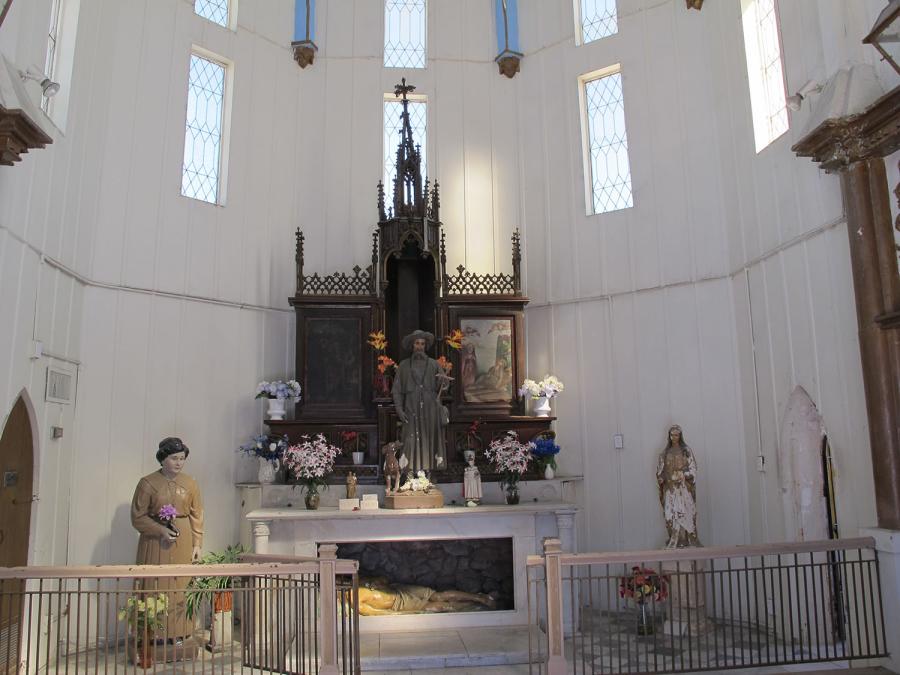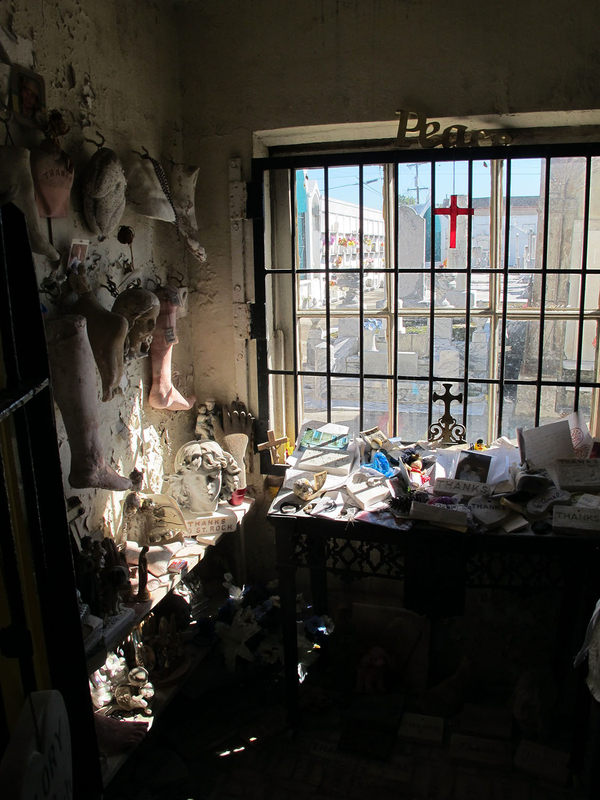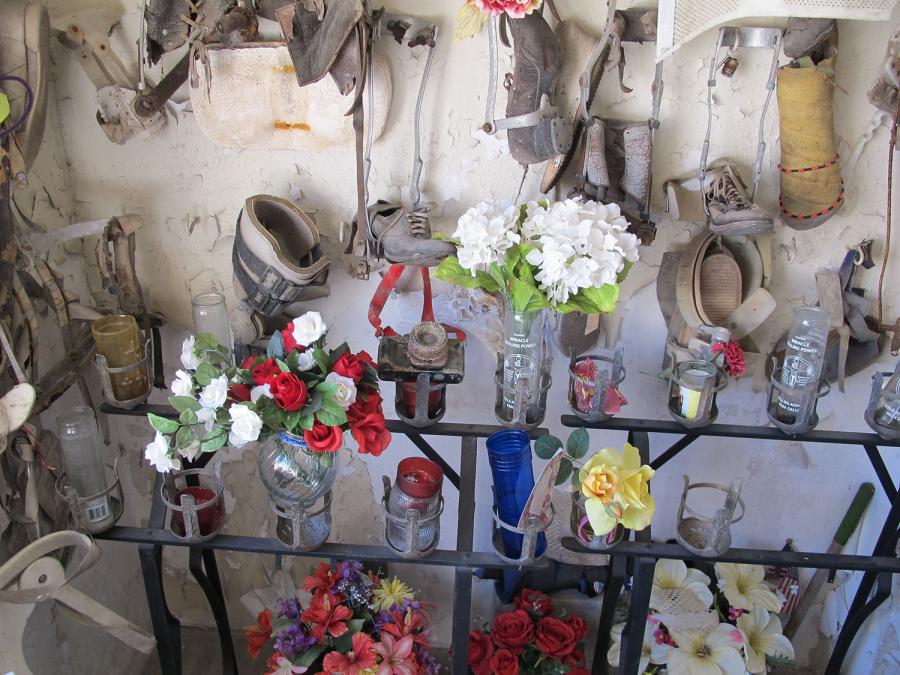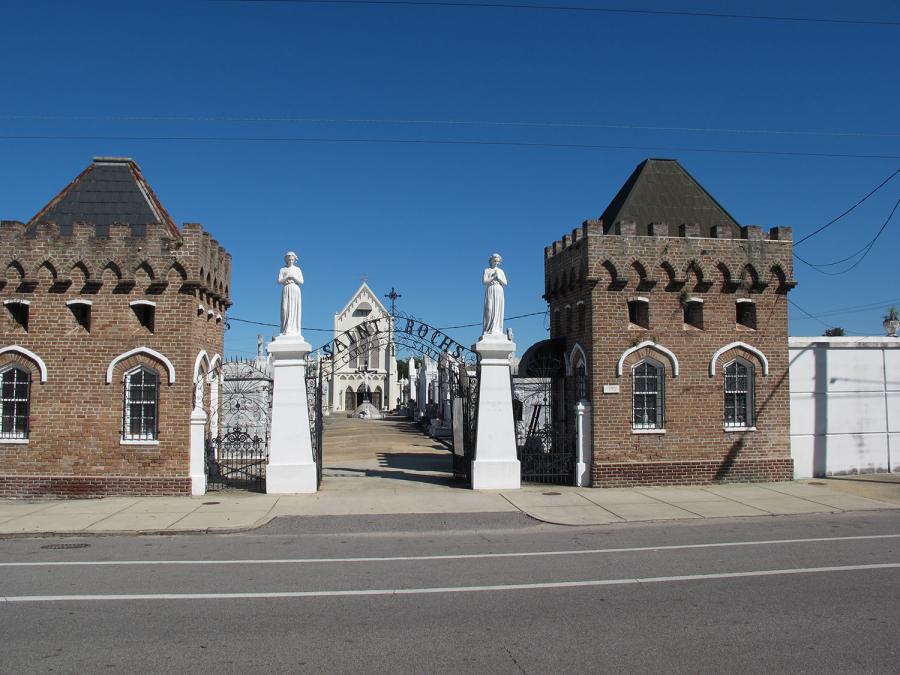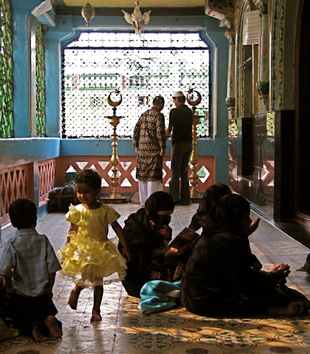The Shrine of St. Roch in New Orleans, Louisiana is a small building consisting of two rooms. The main room contains an altar with a statue of St. Roch, his little dog at his side. To the right of the altar, an iron gate serves as a door to a small chapel. Within, the brick floors and peeling paint of the walls are covered with ex-votos, material objects expressing gratitude for divine intervention.1 The ex-votos come in the form of feet, hands, faces, a brain, and hearts of plaster or plastic as well as photographs, braces, scapulars, and letters tucked in and hung around larger objects. Some of the older ex-votos, including a leg brace, have collected dust and rust, but many other offerings, including photographs and Mardi Gras beads, are more recent.2 While such smaller recent items are numerous, the larger replicas of body parts dominate the space of the small chapel. As objects of exchange, ex-votos “establish a ritualized, reciprocal bond between the giver and receiver.”3 Representations of body parts, as at the Shrine of St. Roch are either expressions of gratitude for a healing or a petition for one, their physical shape metonymically referencing the locus of the illness or injury. Although those leaving such ex-votos do so in hope of healing, these objects occupy a complex place within conceptions of New Orleans as the subject of Protestant fascination with exoticized material aspects of Catholic practice.
Anatomical ex-votos are not surprising at a shrine for St. Roch, a fifteenth-century saint credited with healing plague sufferers.4 From the time of its founding in 1876, the New Orleans Shrine of St. Roch has been associated with healing and protection from illness. Father Peter Leonard Thevis commissioned the shrine and its associated cemetery after the priest’s congregation survived a yellow fever epidemic.5 The city had great need of the saint’s intervention—yellow fever outbreaks in the 1850s,1860s, and 1870s each claimed up to ten percent of the city’s population.6 Ex-voto practices at the shrine reflect this focus on healing, and the age of many of these objects (one leg brace, at least, appears to date back decades) suggests the longevity of these practices.7
Perhaps because the chapel has lost its association with a particular parish and clerical oversight is less stringent, visitors continue to leave ex-votos even though the practice has declined elsewhere in the city. Certainly there are some examples of ex-voto practices at other shrines in New Orleans. In the Iberville neighborhood, for example, at the International Shrine of St. Jude, tiles, inscribed with the words “thank you” in several languages, including English, Spanish, and Vietnamese, line a grotto. Visitors also leave flowers, candles, and the occasional handwritten petition around the statue of St. Jude inside the shrine. Similarly, it is still relatively common to find a few graves decorated with offerings in New Orleans’ Catholic cemeteries. However, nothing comparable to the braces and plaster body parts of the Shrine of St. Roch is evident at the Shrine of St. Jude or elsewhere in New Orleans’ network of Roman Catholic shrines.
Although the Saint Roch ex-votos may intensify a particular aspect of Catholic practice less emphatically expressed elsewhere in New Orleans, Protestant Americans have long seen this presumed intensity of Catholic devotional culture as exotic and other. As early as the 1880s tourist guidebooks referenced the ex-voto practices at the shrine as illustrations of the supposed quaintness of New Orleans Catholicism. In particular, “a bevy of fair damsels” would pray for husbands.8 In 1926, the Los Angeles Times even published a brief feature about this “mecca for unmarried women.”9 Today, as in the nineteenth-century guidebooks, the shrine and adjacent cemeteries continue to function as symbols of New Orleans’ exotic otherness.10 As early as the 1790’s, cultured Protestants began to consider Catholic images in good taste while at the same time “policing, subverting, and neutralizing the throat of the Catholic idol”; Protestants began to colonize Catholic art rather than destroy it.11 Before this change in popular attitudes towards Catholic material culture, many Protestants would have considered the ex-votos at the Shrine of St. Roch as idolatrous. Now bicycle tours stop to take pictures of the altar and surrounding graves.
Although almost none of the top-selling travel guides available on Amazon mention the Shrine of St. Roch, two travel-oriented websites, Lonely Planet and Atlas Obscura, provide descriptions and photographs for curious travelers. Atlas Obscura, which specializes in cataloging “the world’s wondrous and curious places,”12 focuses primarily on the hagiography of St. Roch. Of contemporary practices, the site says little, noting only that, “bric-a-brac of anatomical ex-votos, vintage medical artifacts, and religious iconography has made the Saint Roch Shrine one of the most unusual in America.”13 Similarly, Lonely Planet’s brief description emphasizes “ceramic body parts, prosthetics and false teeth.”14 Divorced from a broader discussion of Catholic culture in New Orleans, the ex-votos appear to be oddities, contributing to New Orleans’ reputation for hauntings and ghost stories.
Devotional and tourist interests in the shrine today exist within the context of the recent gentrification of the neighborhood. Prior to the Civil War, Faubourg St. Roch was home to a large population of free people of color.15 Since then, it has continued to be a primarily black, working-class neighborhood. After the Federal Floods of 200516, investors attracted by lower property prices than in the adjacent, trendy Faubourg Marigny, have bought, renovated, and sold homes at large profits, pushing former residents out. The investors’ efforts to rebrand the neighborhood as the “New Marigny” have brought renewed interest from outsiders, resulting in newspaper and magazine articles about the shrine.17 They also seem to have shaped how the few travel websites mentioning the shrine describe its location. For example, Lonely Planet locates the shrine “a few blocks from Faubourg Marigny” with no mention of Faubourg St. Roch.18
In a final twist to the story, in January of 2015, the Archdiocese of New Orleans announced that due to vandalism and theft, people will no longer be allowed within St. Louis Number 1, the city’s oldest cemetery, without special permission from the Archdiocese, or the accompaniment of a registered tour-guide. St. Louis Number 1 is thus open to tourists drawn by New Orleans’s “exotic” funerary culture and to those able to demonstrate a direct relationship to the deceased, but not to active practitioners of Voodoo, from New Orleans and elsewhere, wishing to leave offerings at the grave of Voodoo Queen Marie Laveau. The Archdiocese expects to extend the same restrictions to the St. Roch shrine and cemeteries. When I inquired with New Orleans Catholic Cemeteries, the division of the Archdiocese of New Orleans in charge of cemeteries, as to the potential reason for the extension, the representative only referred me to the public visiting hours listed on the website. The ex-votos’ presence at St. Roch attest to the continuing power of materiality in contemporary Catholic culture. New restrictions limiting access to the Shrine of St. Roch would undoubtedly restrict these practices, while permitting the continued flow of tourists for many of whom New Orleans’s Catholic material practices are Protestant America’s Other.
Notes
Notes
1. Colleen McDannell, Material Christianity: Religion and Popular Culture in America (New Haven: Yale University Press, 1995), 152. Like the images of body parts, photographs and letters also may serve as ex-votos.
2. Candles, braces, prosthetic limbs, and scapulars, appear to be manufactured. Other ex-votos are handmade with easily obtainable materials, including paper and flowers.
3. Doris Francis, “Introduction: In the Eye of the Beholder,” in Faith and Transformation: Votive Offerings and Amulets from the Alexander Girard Collection (Santa Fe: Museum of New Mexico Press, 2007), 10.
4. "Roch, St." In The Oxford Dictionary of the Christian Church, ed. Cross, F. L., and E. A. Livingstone (Oxford University Press, 2005).
5. Ella Morton, “Honor the Healing Powers of St. Roch by Leaving Him Your Leg,” Slate, May 7, 2014, accessed January 27, 2015, perma.cc/L35C-893R
6 Shirley Elizabeth Thompson, Exiles at Home: the Struggle to Become American in Creole New Orleans (Cambridge: Harvard University Press, 2009), 26.
7. The diversity of objects at the shrine demonstrates that the malleability of St. Roch’s remediations in response to many physical and psychological maladies. Handwritten letters accompanying some ex-votos even petition St. Roch’s help in mending relationships with lovers or family members.
8. Historical Sketch Book and Guide to New Orleans and Environs, with Map (New York: Will H. Coleman, 1885), 116.
9. “New Orleans Shrine Popular with Girls,” Los Angeles Times, March 10, 1926, 4.
10. Stanley Brandes charts the parallel history of Mexican milagros: used as devotional objects predominantly by the working classes, milagros have become fashionable among the upper classes for their aesthetic value. See Stanley Brandes, “Mexican Milagros,” in Faith and Transformation: Votive Offerings and Amulets from the Alexander Girard Collection (Santa Fe: Museum of New Mexico Press, 2007).
11. Sally M. Promey, “Religion, Sensation, and Materiality: an Introduction,” in Sensational Religion: Cultures in Material Practice, ed. Sally M. Promey (New Haven: Yale University Press, 2014), 10
12. “About Us,” Atlas Obscura, accessed September 14, 2015, perma.cc/VX66-HYB5.
13. Laetitia Barbier, “Saint Roch Chapel,” Atlas Obscura, accessed September 14, 2015, perma.cc/8MEQ-2NCM
14. “St. Roch Cemetery,” Lonely Planet, accessed September 14, 2015, perma.cc/XN2N-8G2Y
15. The neighborhood was known as Faubourg Franklin before the 1867 dedication of the Chapel and Cemeteries of St. Roch. “Faubourg St. Roch,” Rebuilding Together New Orleans, accessed September 15, 2015, perma.cc/3628-YD4H
16. Since the flooding following Hurricane Katrina, some community activists have called on people to refer to the floods following the levee failures by names other than “Katrina” to emphasize the federal government’s role in the preventable flooding.
17. See for example Morton, “Honor the Healing Powers of St. Roch," perma.cc/L35C-893R
18. “St. Roch Cemetery,” perma.cc/XN2N-8G2Y
Keywords
Imprint
10.22332/con.obj.2016.2
1. Stephanie Bilinksy, "Ex-Votos, Shrine of St. Roch, New Orleans," Object Narrative, in Conversations: An Online Journal of the Center for the Study of Material and Visual Cultures of Religion (2016), doi:10.22332/con.obj.2016.2
Bilinksy, Stephanie. "Ex-Votos, Shrine of St. Roch, New Orleans." Object Narrative. In Conversations: An Online Journal of the Center for the Study of Material and Visual Cultures of Religion (2016). doi:10.22332/con.obj.2016.2
